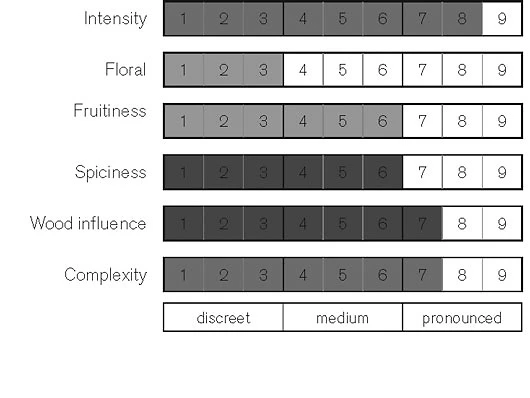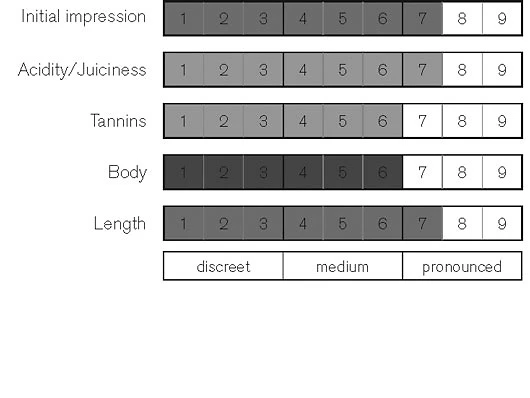Epicurean profile
A wine profile cannot replace a wine description; it can, however, present the main characteristics of a wine so that its fundamental sensory traits are discernible.
The illustrated nose profile rests on two pillars: intensity and complexity. Intensity comprises the perception of aromas released in the glass at the moment a wine is tasted and decidedly characterizes the fi rst impression. Continual nosing will reveal whether the intensity is based on a rather limited or a larger aroma spectrum. If a wine exhibits additional aromas after a longer period of time, its degree of complexity increases. The bars displayed in the graph for the aroma description are limited to floral, fruit and spice aroma categories. Other aromas, such as those from the yeasty, mineral or resinous spectrum for example, sometimes fall under spice or are mentioned in the wine description. Wood influence is listed separately, provided the spice and toast aromas are derived from small wood casks. This offers those clients who, for example, like or dislike wine aged in barrel, an additional tool in selecting their wine.
The palate profile is based on the understanding that mouth perception consists of three chronological phases (initial impression, development and finish).
When you drink a wine its characteristics of smoothness are the fi rst to be observed. Wine components such as alcohol, glycerin or possibly existing residual sugar intensify the initial impression. Only over time does the wine begin to reveal its structure. Acidity, which produces saliva and juiciness, is a key structural element. Red wines contain tannins which represent an additional element that contributes to structure. On the palate these exhibit sensations of dryness or astringency. White wines can also appear dry on the fi nish, even when they only contain a low level of tannins. One of the various reasons for this phenomenon lies in a certain saltiness, which is also described as minerality.
In all phases of the tasting, wine aromas released in the mouth play a signifi cant role. They are particularly important in the perception of length. Wines that display fewer aromas on the fi nish are generally described as short. Body, therefore, being the sum of all characteristics perceived on the palate, is only suffi ciently full when the palate structure is embedded in a signifi cantly wide range of aromas.
Example: Eleonora

Intensity encompasses the amount of aromas a wine releases mainly at the outset.
Floral and fruitiness refer to two aroma categories which constitute a large part of a wine’s bouquet.
Spiciness is a collective term for spices derived from herbs, seeds, roots and barks as well as related aroma categories.
Wood influence expresses itself – when it is derived from relatively new oak casks – mostly in notes of spice and toast.
Complexity reflects the range of the aroma spectrum and its evolution as the wine is enjoyed.

The initial impression covers the sensations observed the moment the wine first comes in contact with the palate.
Acidity and tannins constitute a wine’s structure. In the case of white wines in particular, the term minerality is often used to describe detected saltiness.
Body corresponds to all sensory perceptions from the initial impression to the finish.
Length is closely linked to the after-effects of aromas detected on the palate. This should be in harmony with the structural complexity and adequately supplement it.
